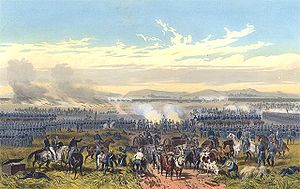Battle of Palo Alto
| Battle of Palo Alto | |||||||
|---|---|---|---|---|---|---|---|
| Part of the Mexican-American War | |||||||
 Painting by Carl Nebel | |||||||
| |||||||
| Belligerents | |||||||
| United States | Mexico | ||||||
| Commanders and leaders | |||||||
| Zachary Taylor | Deputy Gen. P.Ampudia,Artillery-Gen. T. Requena | ||||||
| Strength | |||||||
| 2,400 infantry |
2,300 infantry, 1,100 cavalry and 160 artillery 12 guns | ||||||
| Casualties and losses | |||||||
|
9 killed 45 wounded 2 captured [1] |
125~ killed 200~ wounded 26 captured [1] | ||||||
The Battle of Palo Alto was the first major battle of the Mexican-American War and was fought on May 8, 1846, on disputed ground five miles (8 km) from the modern-day city of Brownsville, Texas. A force of some 3,400 Mexican troops (a portion of the Army of The North) led by General Mariano Arista, with the Diaz de La Vega & Garcia Infantry Brigades (2d Light, 1st, 6th & 10th Line Infantry regiments, Tampico Garda Costa Battalion & Company)& the Torrejon Cavalry Brigade (7th & 8th Line Cavalry, Mexico Light Cavalry Regiments, Presidial Companies & Rancheros Irregular Cavalry) engaged a force of 2,400 United States troops — the so called US Army of Observation.(Right Wing :Col. Twiggs with 5th Infantry (Lt. Col. McIntosh), Ringgold's Light Artillery, 3d Infantry (Capt. Morris), Lt. Churchill's Artillery (2-18 pounders), 4th Infantry (Major Allen)& Captains Ker & May Dragoon Squadrons. Left Wing: Lt. Col. Belknap with Lt. Col. Child's Artillery Battalion (serving as Infantry), and 8th Infantry (Capt. Montgomery)
Background
The battle occurred as a result of Mexican efforts to besiege a U.S. army installation, "Fort Texas",(Garrison:Major Brown with 7th Infantry, Capt. Loud's Artillery Co.with 4- 18 pounders, & Lt. Bragg's Light Artillery 4guns )which the Mexicans viewed as having been built within the boundaries of Mexican Texas. General Zachary Taylor, receiving supplies from Port Isabel, heard the distant report of cannon fire. The Mexicans had begun to attack Fort Texas. Taylor gathered his troops and rushed to relieve the defenders of the fort but was intercepted by a Mexican force commanded by General Arista. Another Mexican force (1,540 men, including Artillery 14 Guns, Matamoros Natl. Guards Battalion, Mexico, Puebla & Morelia Activoes Battalions) under General Francisco Mejia were left behind at Fort Brown & Matamoros.
Battle
General Arista's army was stretched a mile wide, making an American bayonet charge impossible. Taylor, in an unlikely move, advanced his artillery to attack the enemy. It was this "Flying Artillery"—the tactic of using light artillery to attack then quickly move to another location and fire once more, developed by Major Samuel Ringgold—that won the battle for the Americans. The Mexican artillery, heavy and slow, was futile in the thick brush at Palo Alto. Arista ordered cavalry charges to flank the artillery gunners, but the American "Flying Artillery" was able to mobilize, relocate, and repel the oncoming dragoons.
Aftermath
Ringgold died of wounds inflicted in the battle, but his death spurred a significant boost to morale across America. After the first day, Taylor arose to find that the Mexicans had withdrawn from the field of battle and moved camp to the site of the next engagement, Resaca de La Palma.
Mexicans suffered large casualties compared to the Americans for several reasons. The Mexican army had poor gunpowder compared to the Americans, shortening the range of their cannon and musket fire. The poor powder had a tendency to explode prematurely and caused many soldiers to pour smaller amounts of gunpowder, further affecting the range of their weapons. Mexican soldiers usually had little training and were often scared of the volatile gunpowder. The Mexicans, as was typical throughout the war, had technologically inferior weaponry to the Americans. The musket Arista's men used was the British Brown Bess — the same weapon the British had used during the Napoleonic Wars and American Revolutionary War a century before.
The venue is now Palo Alto Battlefield National Historic Site and is maintained by the National Park Service.

See also
- Battles of the Mexican-American War
- List of conflicts in the United States
- Hispanic Heritage Sites (U.S. National Park Service)
References
Alcaraz, Ramón, "Apuntes para la historia de la guerra entre México y los Estados Unidos" Balbotín, Manuel, "La invasión americana, 1846 a 1848, apuntes del subteniente de artillería" Bauer, K. Jack, "The Mexican-American War, 1846-1848" 8===D Chartrand, René, "Santa Anna's Mexican Army, 1821-1848" Crawford, Mark, "Encyclopedia of the Mexican-American War" Haecker, Charles M., "On the Prairie of Palo Alto" Brooks, N. C., "A Complete History of The Mexican War"
